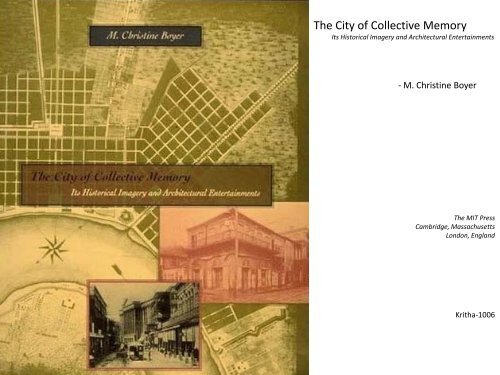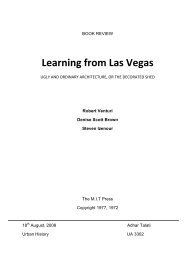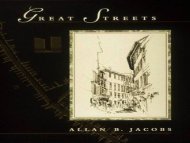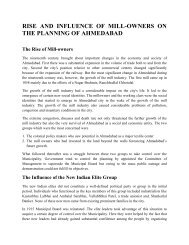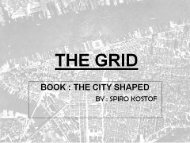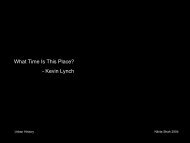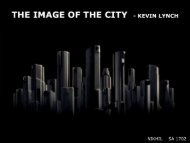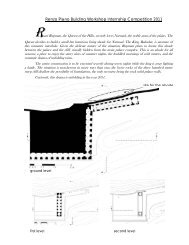The City of Collective Memory
The City of Collective Memory
The City of Collective Memory
You also want an ePaper? Increase the reach of your titles
YUMPU automatically turns print PDFs into web optimized ePapers that Google loves.
<strong>The</strong> <strong>City</strong> <strong>of</strong> <strong>Collective</strong> <strong>Memory</strong><br />
Its Historical Imagery and Architectural Entertainments<br />
- M. Christine Boyer<br />
<strong>The</strong> MIT Press<br />
Cambridge, Massachusetts<br />
London, England<br />
Kritha-1006
• “<strong>Collective</strong> <strong>Memory</strong>” , in general, refers to shared memories <strong>of</strong> a particular group or family<br />
framed in space and time.<br />
Eg. <strong>Collective</strong> <strong>Memory</strong> <strong>of</strong> a nation is represented partly by the memorials it chooses to erect.<br />
Whatever a nation chooses to memorialise in a physical monument is an indicator <strong>of</strong> its<br />
collective memory.<br />
• <strong>The</strong> city is a colllective expression <strong>of</strong> architecture and it carries the memory traces <strong>of</strong> earlier<br />
architectural forms, city plans and public monuments.<br />
• <strong>The</strong> physical structure <strong>of</strong> a city always evolves ,being deformed or forgotten, adapted to<br />
other purposes or eradicated by different needs.
<strong>The</strong> Generating Powers <strong>of</strong> a <strong>City</strong> Plan<br />
• <strong>The</strong> contemporary city suffers from an inadequate and misguided process <strong>of</strong> planning, and so<br />
the reexamination <strong>of</strong> some <strong>of</strong> the latter’s historical roots might awaken forgotten intentions.<br />
• Behind every city plan lies a belief that society is progressing towards a better future.<br />
• A city should become the locus <strong>of</strong> collective memory and not simply an outdoor museum or<br />
a collection <strong>of</strong> historical districts.
Inversion <strong>of</strong> Public & Private Space<br />
• <strong>The</strong> word “public” is misrepresented when applied to city places.<br />
• Before the end <strong>of</strong> 18 th century public space was usually designed as an honorific place to celebrate<br />
the power <strong>of</strong> the king, queen or aristocracy holding tableaux vivants.<br />
• Due to the revolutions in the 18th and 19th centuries, public spaces became democratic spheres<br />
where public space was extended to include places <strong>of</strong> public debates and gatherings.<br />
• Public authority was linked to a system <strong>of</strong> norms and regulations.<br />
• Throughout the 19 th century, illiterate class grew in numbers, the public sphere was<br />
reconceptualised in terms <strong>of</strong> the rich and the poor.<br />
• With the beginning <strong>of</strong> the 20 th century, municipal buildings, public libraries, railroad stations, public<br />
parks etc came up to establish beauty & order.
• In the last few decades, “public” has become a negative concept comprising <strong>of</strong> unruly<br />
bureaucracies, corrupt <strong>of</strong>ficials, inefficient management.<br />
• “Private” has been refurbished with a new image: freedom <strong>of</strong> choice and style.<br />
• Civic improvement schemes play on this inversion <strong>of</strong> values- creating private preserves for<br />
the wealthy which are transformed into “public amenities”.<br />
• Thus, city’s public is fragmented into marginalised groups.
<strong>City</strong> Images & Representional Forms<br />
• 3 aesthetic conventions representing the image <strong>of</strong> cities in the traditional, modern &<br />
contemporary time periods are identified: 1. <strong>The</strong> <strong>City</strong> as a Work <strong>of</strong> Art,<br />
2. <strong>The</strong> <strong>City</strong> as Panorama,<br />
3. <strong>The</strong> <strong>City</strong> <strong>of</strong> Spectacle.
<strong>The</strong> <strong>City</strong> as a Work <strong>of</strong> Art<br />
• Until the end <strong>of</strong> the 19 th century, builders <strong>of</strong> modern<br />
industrial cities were absorbed with picture-making.<br />
• This picture frame became emblematic <strong>of</strong> its unified<br />
and closed spatial order.<br />
• This period witnessed an architecture <strong>of</strong> ceremonial<br />
power whose monuments spoke <strong>of</strong> exemplary deeds,<br />
national unity and industrial glory.<br />
• <strong>The</strong> <strong>City</strong> as a Work <strong>of</strong> Art was an attempt to fulfill<br />
cultural and aesthetic needs destroyed in the turmoil<br />
<strong>of</strong> progress.<br />
View <strong>of</strong> Palace de la Concorde
<strong>The</strong> <strong>City</strong> as Panorama<br />
• In the early 20 th century the city appeared as an open &<br />
expansive panorama, ruled by the transformation <strong>of</strong><br />
space & time that modern modes <strong>of</strong> travel provided.<br />
• <strong>The</strong> pictorial image <strong>of</strong> the <strong>City</strong> as a Work <strong>of</strong> Art was<br />
replaced by the city <strong>of</strong> soaring skyscrapers.<br />
• Railroad travel had erased the idea <strong>of</strong> in-between space.<br />
• Mobility in space thus enabled a juxtaposition <strong>of</strong><br />
disparate but sequential images.<br />
• So the city was no longer seen from a static frontal<br />
perspective, but as a multidimensional traveling view<br />
that was itself a new spatialization <strong>of</strong> space.<br />
Robert Delaunay, Eiffel Tower
<strong>The</strong> <strong>City</strong> <strong>of</strong> Spectacle<br />
• By the 1980s, the transformation <strong>of</strong> the material<br />
world by invisible bands <strong>of</strong> electronic communication.<br />
• It decomposed the bits and pieces <strong>of</strong> the city into an<br />
ephemeral form.<br />
• Art & architecture based on the recomposition &<br />
recombination <strong>of</strong> borrowed imagery appeared to<br />
make reality.<br />
• <strong>The</strong>re was a juxtapositioning <strong>of</strong> high and low art<br />
forms to give a sense <strong>of</strong> theatricality.<br />
• <strong>The</strong>re was revitalization <strong>of</strong> traditional building<br />
typologies or construction <strong>of</strong> new compositions.<br />
Paul Citroen, Metropolis
<strong>The</strong> Politics <strong>of</strong> Representational Forms<br />
• As every economic formation or structure engenders a cultural form or an aesthetic<br />
convention, the representational forms <strong>of</strong> the <strong>City</strong> as a Work <strong>of</strong> Art, Panorama, or Spectacle<br />
reflect different stages <strong>of</strong> capitalism.<br />
• <strong>The</strong> term “work <strong>of</strong> art” implied that there existed a market for these “works”, that art was a<br />
commodity for sale & no longer limited only to the aristocrats.<br />
• This 19 th century art market was compromised : the old aristocrats and acamedicians still<br />
ruled over popular taste.<br />
• To cover the changes wrought by political revolutions, industrialization, rise <strong>of</strong> capitalists with<br />
their materialistic aspirations, old styles such as Gothic, Baroque or Classical was used all over<br />
again.<br />
• Thus the battle <strong>of</strong> styles & the <strong>City</strong> as a work <strong>of</strong> art were nothing other than a backward<br />
binding gesture.
<strong>The</strong> <strong>City</strong> <strong>of</strong> <strong>Collective</strong> <strong>Memory</strong><br />
• <strong>The</strong> <strong>City</strong> <strong>of</strong> <strong>Collective</strong> <strong>Memory</strong> should focus on creation <strong>of</strong> meaningful & imaginative public<br />
spaces.<br />
• Should have continuous urban topography, a spatial structure that covers both rich and poor<br />
places, honorific and humble monuments, permanent and ephemeral forms, and should<br />
include places for public assemblage and public debate, as well as private memory walks and<br />
personal retreats.<br />
• In the <strong>City</strong> <strong>of</strong> <strong>Collective</strong> <strong>Memory</strong>, the architect, city planner, and spectator must begin to<br />
move beyond the will to instrumentally formulate historical unities.<br />
• It should have a play <strong>of</strong> oppositions, the existence <strong>of</strong> randomness, disturbances, dispersions<br />
& accidents.<br />
• <strong>The</strong> <strong>City</strong> <strong>of</strong> <strong>Collective</strong> <strong>Memory</strong> will require a double reading <strong>of</strong> 19 th & late 20 th century forms.


